
Arie Luijendijk is a Dutch former auto racing driver, and winner of the 1990 and 1997 Indianapolis 500 races. He was inducted into the Indianapolis Motor Speedway Hall of Fame in 2009, and the Motorsports Hall of Fame of America in 2014. He is also known as "The Flying Dutchman".

Speed Racer, also known as Mach GoGoGo, is a Japanese media franchise about automobile racing. Mach GoGoGo was originally serialized in print in Shueisha's 1966 Shōnen Book. It was released in tankōbon book form by Sun Wide Comics and later re-released in Japan by Fusosha. Adapted into anime by Tatsunoko Productions, its 52 episodes aired on Fuji TV from April 1967 to March 1968. In the US, the program aired on ABC. at approximately the same time. The anime was later re-broadcast on Tokyo MX from July 1 to September 25, 2008.

Wacky Races is an American animated television series produced by Hanna-Barbera Productions for Saturday mornings. The series features 11 different cars racing against each other in various road rallies throughout North America, with all of the drivers hoping to win the title of the "World's Wackiest Racer". The show was inspired by the 1965 comedy film The Great Race.

WWE Heat is a professional wrestling television program that was produced by World Wrestling Entertainment (WWE). Originally produced under the World Wrestling Federation banner (WWF), it aired on USA Network, MTV, and Spike TV in the United States, CTV Sportsnet in Canada, and Channel 4, Sky1, and Sky Sports in the United Kingdom. From 2002, due to the WWE brand extension, Heat served as a supplementary show to the Raw brand, focusing more exclusively on its mid-card performers and matches, and was recorded before the week's television taping of Raw.
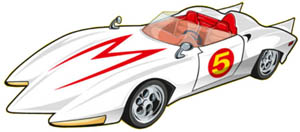
The Mach Five is the racing car Speed Racer drives in the anime series of the same name. The car was designed, built, and created by "Pops Racer", Speed Racer's father. It features a set of special devices which Speed Racer uses throughout the series. In the original 1967 series, the Mach Five is a white racing car with an "M" written on its hood. In the 1993 American remake, the design was completely changed.

Pinks is the primary television series in a franchise series of television programs on Speed based on street racing, held at legal closed drag strips with a theme around drag racing. The original aired from 2005 to 2008, with the spinoff Pinks: All Out following in 2006 until 2010. The name of the show, and the tagline "Lose the race – lose your ride", refer to common slang of pink slips representing a vehicle's title document recording ownership, and the derivative street-racing phrase, "racing for pinks," meaning a race in which the winner earns the loser's car.
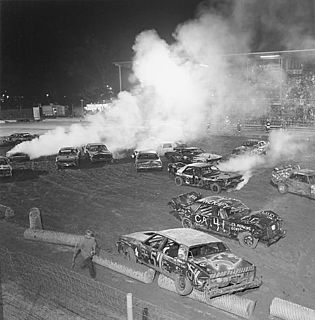
Demolition derby is a non-racing motorsport usually presented at county fairs and festivals. While rules vary from event to event, the typical demolition derby event consists of five or more drivers competing by deliberately ramming their vehicles into one another. The last driver whose vehicle is still operational is awarded the victory. Demolition derbies originated in the United States and quickly spread to other Western nations. For example, Australia's first demolition derby took place in January 1963. In the UK and parts of Europe, demolition derbies are often held at the end of a full day of banger racing.
Street racing is typically an unsanctioned and illegal form of auto racing that occurs on a public road. Racing in the streets is considered an ancient hazard, as horse racing occurred on streets for centuries, and street racing in automobiles is likely as old as the automobile itself. It became especially prevalent during the heyday of hot rodding (1960s), muscle cars (1970s) and Japanese imports (1990s). Since then, it continues to be both popular and hazardous, with deaths of bystanders, passengers, and drivers occurring every year. In the United States, modern street racing traces its roots back to Woodward Avenue, Michigan, in the 1960s when the three main Detroit-based American car companies were producing high-powered performance cars. Since a private racing venue was not always available, street races would be held illegally on public roads.
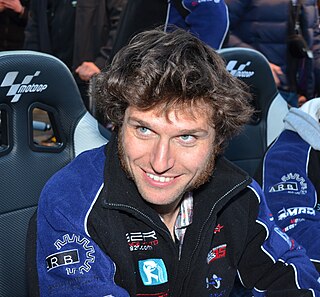
Guy Martin is a British former motorcycle racer and heavy vehicle mechanic who became a television presenter. In July 2017, Martin retired from motorcycle racing.

Racer X is a recurring fictional character in the manga and anime series Speed Racer.

Jessica Combs was an American professional racer, television personality, and metal fabricator. She set a women's land speed class record in 2013 and broke her own record in 2016. She was known as "the fastest woman on four wheels".

The 2010 NASCAR Sprint Cup Series was the 62nd season of professional stock car racing in the United States, the 39th modern-era cup series, and the first Cup season of the 2010s, the 21st century's second decade. Beginning at Daytona International Speedway, the season included 36 races and two exhibition races. The season concluded with the 2010 Ford 400 at Homestead-Miami Speedway. During the 2009 offseason, NASCAR announced a few calendar changes, including the standardized start time. Rick Hendrick won the Owners' Championship, while Jimmie Johnson won the Drivers' Championship with a second-place finish at the final race of the season. Chevrolet won the Manufacturers' Championship with 261 points. Johnson extended his record of consecutive championships with the 5th title in a row. 2010 is the first season without drivers Jeremy Mayfield since 1992 and Sterling Marlin since 1975.

Islip Speedway was a .2-mile (320-meter) oval race track in Islip, New York which was open from 1947 until 1984. It is the smallest track to host NASCAR's Grand National Series, from 1964 to 1971. The first demolition derby took place at Islip Speedway in 1958. The idea was patented by Larry Mendelsohn, who worked at Islip Speedway. The speedway has since been demolished.

Snowboard cross, also known as boardercross, is a snowboard competition in which four to six competitors race down a course. Snowboard cross courses are typically quite narrow and include cambered turns, various types of jumps, berms, rollers, drops, steep and flat sections designed to challenge the riders' ability to stay in control while maintaining maximum speed. It is not uncommon for racers to collide with each other mid-race.

The Granville Gee Bee Model Z was an American racing aircraft of the 1930s, the first of the Super Sportster aircraft built by Granville Brothers Aircraft of Springfield, Massachusetts, with the sole intent of winning the Thompson Trophy, which it did in 1931. However, it soon suffered a fatal crash during a world speed record attempt, starting the reputation of the Gee Bee aircraft as killers.
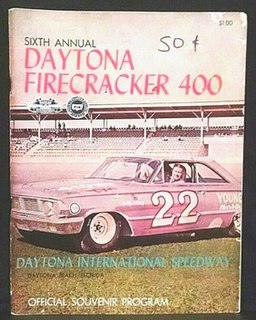
The 1964 Firecracker 400 was a NASCAR Grand National Series event that was held on July 4, 1964, at Daytona International Speedway in Daytona Beach, Florida. It was the first NASCAR Grand National Series race to take place after Fireball Roberts died two days earlier in the infamous 1964 World 600.
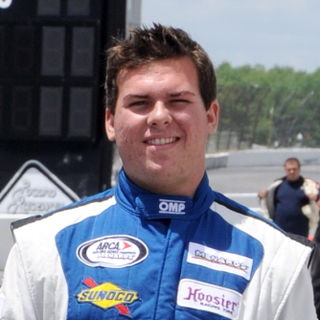
Michael Lira is a Peruvian-American professional stock car racing driver.
As time passed, more Winston Cup races ended up on TV. ESPN broadcast its first race in 1981, from North Carolina Motor Speedway, and TNN followed in 1991. All Cup races were nationally televised by 1985; networks struck individual deals with track owners, and multiple channels carried racing action. Many races were shown taped and edited on Wide World of Sports and syndication services like Mizlou and SETN, but almost all races were live by 1989. By 2000, the last year of this arrangement, six networks televised at least one Cup series race: CBS, ABC, ESPN, TNN, TBS, and NBC.
Until 2001, race tracks struck individual agreements with networks to broadcast races, but NASCAR wanted to capitalize on the growing popularity of the sport and announced in 1999 that television contracts would now be centralized; that is, instead of making agreements with individual tracks, networks would now negotiate directly with NASCAR for the rights to air a package of races.















